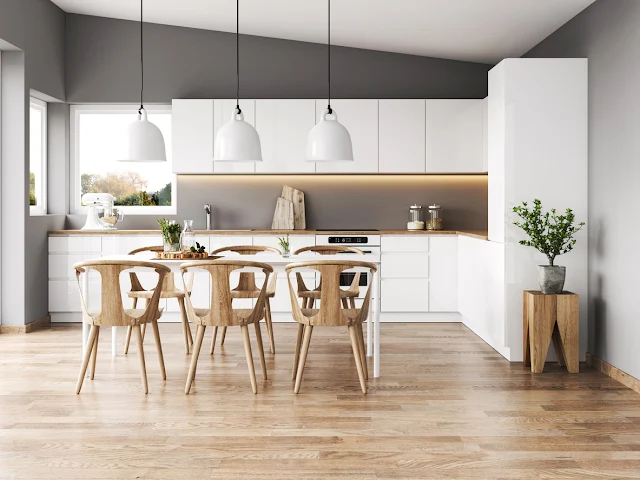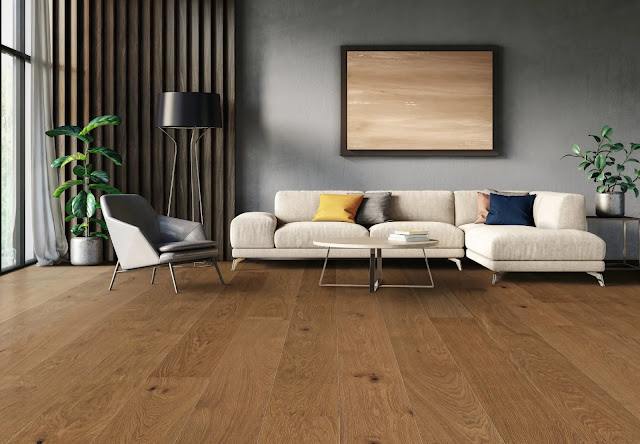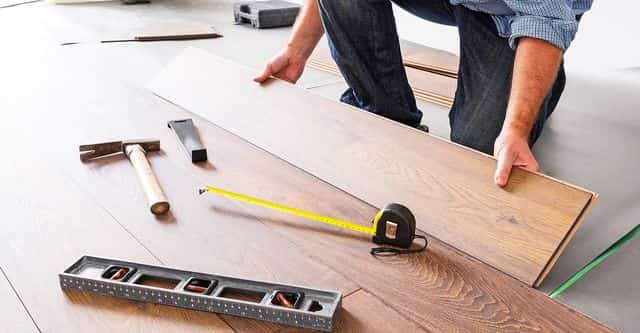Which Floor To Choose For The Kitchen? The 6 Best Floors, Their Advantages And Disadvantages
Are you renovating or furnishing a brand new kitchen and waiting for you to choose a floor? This is certainly one of the most important decisions because high demands will be placed on the floor.
It must not only be nice to look at but also withstand practical use and the effects of influences that may occur in this space. There are a lot of options and materials from which the floor can be made, and if everything makes your head spin, it's no wonder.
In this article, we will try to help you a
little. We will not directly choose the kitchen floor for you, but we will
briefly and clearly introduce you to the basic options. We will try to describe
their most distinctive features, advantages - and of course, last but not
least, also disadvantages. So what kind of kitchen floor can you buy? Let's
take a look at it.
Comparison
Of The Best Kitchen Floors
1. Vinyl Flooring
Vinyl floors are a hit nowadays and more and more people are leaning towards this solution, which definitely offers a good ratio of price and practical benefits.
Vinyl floors are available in several forms. A popular option is glued vinyl flooring, which can be available either in rolls or in individual stick-on pieces. Glued vinyl floors are perfect for kitchens due to their high resistance to water and load-bearing capacity.
The load classes of modern vinyl floors are high, even extremely high - that is why they are used not only in homes but also in commercial and other spaces. Glued floors are lower, so they are perfectly combined with underfloor heating.
However, they also have a few disadvantages. For example, it is a more demanding installation that requires a perfectly level surface. Possible repairs are more complicated for roll variants.
Another variant of vinyl floors is
interlocking floors, which are higher, have a softer tread, and are much easier
to lay on the principle of floating floors. Other varieties are vinyl floors
with an HDF substrate, often combined with a cork layer. Again, these are
floors that perfectly match the kitchen. Due to the rigid core, they are more
permanent in shape than the glued variants, but again they are more expensive.
Advantages Of Vinyl Flooring
●
High resistance,
water resistance, high load classes;
●
Generally
advantageous properties for use in the kitchen;
●
An extensive
selection of decors and a non-slip surface are also common;
●
They can also be
relatively affordable;
●
Modern floors are
already harmless to health
Disadvantages Of Vinyl Flooring
●
More demanding
installation for glued variants;
●
Artificial
material.
The Cost Of Vinyl Flooring
Available glued variants start at prices
around $15-$18 per square meter. Floors with the click system and variants with
rigid cores are more expensive - expect a price of around $30-$35 per square
meter. On the other hand, there is an easier installation that you can easily
handle yourself.
2. Linoleum Flooring
Another very popular current choice is natural linoleum flooring, which is a material made from natural raw materials, including resin, linseed oil, wood or cork flour, jute, and other ingredients. The result is a covering of many qualities, which is also completely healthy and ecological.
It is great for people who are trying to reduce allergens in their home, as well as potentially irritating and artificial substances of all kinds.
Natural linoleum fits really well in the
kitchen. It is naturally excellently waterproof and has a very good load and
mechanical resistance. High acoustic insulation properties and a pleasant
foothold will also please you. Heat conduction is also good, this covering has
a relatively warm underfoot.
Advantages
●
High load
resistance and water resistance;
●
The optimal
solution for use in the kitchen;
●
Ecological and
harmless to health.
Disadvantages
●
More demanding
laying of glued variants;
●
Rather higher
prices;
● Less cut resistance.
Prices: Linoleum
More affordable glued natural linoleum can
normally be purchased from about $28-$32 per square meter. After all, floating
linoleum will cost you more, from about $52-$55 per square meter.
3. Laminate Flooring
Laminate flooring is sometimes considered almost synonymous with floating floors. The reason is that a floating solution is typical for laminate floors, moreover, they are extremely widespread and in demand for their affordability. But is laminate also suitable for the kitchen?
Generally speaking, the basis of laminate floors are boards made of MDF materials - i.e. wood fiber boards pressed under pressure. Wood and moisture are generally not the best combination, and resistance to moisture and water is important in the kitchen.
There are variants made with an emphasis on
higher water resistance, precisely because of the possibility of use in the
kitchen. Usually, the base is a denser MDF board. Such laminate floors can be
more expensive, while the low price is one of the main attractions for
purchasing this type of covering.
Advantages
●
From very
affordable prices;
●
Good durability;
●
Easy maintenance;
●
Choice of decors;
●
Very easy
installation
Disadvantages
●
Not all of them
have optimal properties for use in the kitchen;
●
Worse soundproofing
properties.
Laminate Flooring Prices
The prices of floating laminate floors can
start as low as $11-$13 per meter. However, the cheapest variants may not be
suitable for the kitchen due to insufficient water resistance.
4. Hardwood Flooring
The right hardwood floor for the kitchen? It is not a completely usual choice, but it can be a very nice design solution, for example, rustically furnished houses or cottages. But how about the practical features? In particular, cheap and softwoods do not have the necessary resistance and water resistance.
A high-quality oak floor can already be an option, but there is a condition that you take good care of it, and give it regular care - in this case, it can last a very long time. An even better – and also more expensive – option is floors made of exotic woods, which have excellent natural water resistance and are also suitable for outdoor spaces.
Wood is a natural, noble, and beautiful
material, and it can also successfully find its place in the kitchen. However,
this does not change the fact that it is rarely the first choice, let alone a
cheap one.
Advantages
●
Beautiful
appearance, natural material;
●
Excellent to
extreme durability;
●
Excellent
durability.
Disadvantages
●
It is necessary to
choose a high-quality hardwood that is resistant to moisture;
●
More expensive to
expensive solutions;
●
More demanding
maintenance.
So, Which Floor Is The Best?
Have you always been proud of your interior, but lately you feel that the space in the apartment or family house is drab? Year after year you try to improve it with various home accessories, but somehow it doesn't work. You are thinking! What you wanted to avoid is here - replacing the floor covering. You sigh and wonder what flooring would be best?
Definitely wooden! After all, it is a natural material that will bring a piece of peace and nature into the interior. Or laminate? It takes on the appearance of a wooden floor and can still withstand everything possible in the interior.
Maybe vinyl, because it is able to
withstand even animal claws. Damn, there are so many materials on the market,
you think. So how to find the best for your interior?
The Best
Floor Is ...?
Now if you are expecting us to tell you that this particular floor is the best, then you are wrong. Each floor covering is the best in its own way, as each has different properties and fulfills different requirements. For example, the one that is best for the kitchen is not necessarily the best for the bedroom, and vice versa.
So, when choosing a floor, it is therefore
necessary to take into account where you will place it and what you expect from
it. That's the only way to choose the best covering for every room.
A Long-term Investment
Investing in flooring is a long-term thing unless you plan to change it year after year. When choosing it, consider both
the quality of the covering and the appearance itself, which you won't get
tired of even after years. Our tip is to choose more neutral floor colors that
better adapt to the changing color shades of the walls and home accessories.
Our Advice
For Choosing The Best One
If you are disappointed that we did not advise you on the best floor covering, then at least we have a small guide that could help you with your choice. As we have already mentioned, each room has its own specific characteristics and difficulty of use.
Today there are so many options that you no
longer have to follow tradition. So you don't have to choose only tiles for the
bathroom, but you can also lay wood. However, it is important that you choose
the right material that will be resistant to moisture. And so it is with the
other rooms.
Living Room
This is a room for relaxation and rest,
here you can choose from less durable floor coverings. Classic solid wood, and cheaper three-layer or two-layer floors are a great choice. Laminate floors or
ordinary PVC floors are also very popular.
Bedroom
Just like the living room, it is a room of
peace, relaxation, and well-being, therefore the floor should be cozy, pleasant
for bare feet, and warm. Suitable materials are wood, linoleum, cork, hardened
vinyl, laminate, and carpet.
Children's Room
We always want the best for the little
ones. Therefore, choose a material that is pleasant to the touch, warm, durable, and easy to maintain. Ideal materials include, for example, linoleum, vinyl,
cork, or wood. Laminate isn't bad either, it's just a little cooler for our
feet.
The Kitchen
Running water, spilled sauce, broken
dishes, a dropped knife - common domestic disasters that happen to us right in
the kitchen. In order for the floor to survive all this, it is necessary to
choose a highly resistant floor covering. In this case, laminate, SPC vinyl,
and PVC are great choices.
Bathroom
This room is always wet and humid. So
choose a durable floor for these spaces that can handle daily moisture and is
easy to maintain. We recommend laminate, vinyl, and PVC, but also a wooden floor
suitable for these spaces.
The Bottom Line
We probably didn't make your choice easy
with our long list. So if you don't know what to do, get advice from the
flooring experts from Floor N More, who will help you choose the best
possible solution.







Comments
Post a Comment